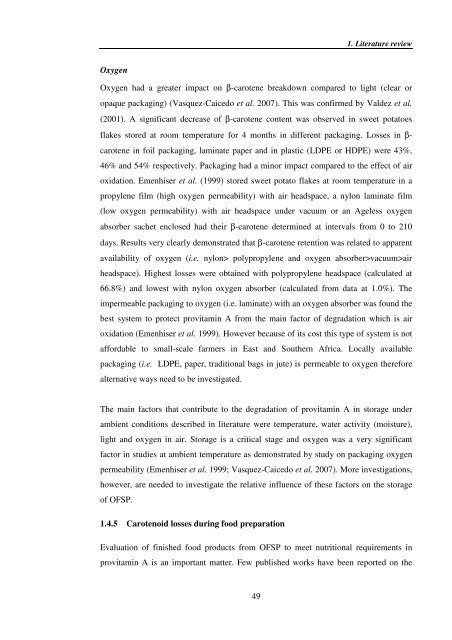Investigating carotenoid loss after drying and storage of
Investigating carotenoid loss after drying and storage of
Investigating carotenoid loss after drying and storage of
You also want an ePaper? Increase the reach of your titles
YUMPU automatically turns print PDFs into web optimized ePapers that Google loves.
Oxygen<br />
49<br />
1. Literature review<br />
Oxygen had a greater impact on β-carotene breakdown compared to light (clear or<br />
opaque packaging) (Vasquez-Caicedo et al. 2007). This was confirmed by Valdez et al.<br />
(2001). A significant decrease <strong>of</strong> β-carotene content was observed in sweet potatoes<br />
flakes stored at room temperature for 4 months in different packaging. Losses in β-<br />
carotene in foil packaging, laminate paper <strong>and</strong> in plastic (LDPE or HDPE) were 43%,<br />
46% <strong>and</strong> 54% respectively. Packaging had a minor impact compared to the effect <strong>of</strong> air<br />
oxidation. Emenhiser et al. (1999) stored sweet potato flakes at room temperature in a<br />
propylene film (high oxygen permeability) with air headspace, a nylon laminate film<br />
(low oxygen permeability) with air headspace under vacuum or an Ageless oxygen<br />
absorber sachet enclosed had their β-carotene determined at intervals from 0 to 210<br />
days. Results very clearly demonstrated that β-carotene retention was related to apparent<br />
availability <strong>of</strong> oxygen (i.e. nylon> polypropylene <strong>and</strong> oxygen absorber>vacuum>air<br />
headspace). Highest <strong>loss</strong>es were obtained with polypropylene headspace (calculated at<br />
66.8%) <strong>and</strong> lowest with nylon oxygen absorber (calculated from data at 1.0%). The<br />
impermeable packaging to oxygen (i.e. laminate) with an oxygen absorber was found the<br />
best system to protect provitamin A from the main factor <strong>of</strong> degradation which is air<br />
oxidation (Emenhiser et al. 1999). However because <strong>of</strong> its cost this type <strong>of</strong> system is not<br />
affordable to small-scale farmers in East <strong>and</strong> Southern Africa. Locally available<br />
packaging (i.e. LDPE, paper, traditional bags in jute) is permeable to oxygen therefore<br />
alternative ways need to be investigated.<br />
The main factors that contribute to the degradation <strong>of</strong> provitamin A in <strong>storage</strong> under<br />
ambient conditions described in literature were temperature, water activity (moisture),<br />
light <strong>and</strong> oxygen in air. Storage is a critical stage <strong>and</strong> oxygen was a very significant<br />
factor in studies at ambient temperature as demonstrated by study on packaging oxygen<br />
permeability (Emenhiser et al. 1999; Vasquez-Caicedo et al. 2007). More investigations,<br />
however, are needed to investigate the relative influence <strong>of</strong> these factors on the <strong>storage</strong><br />
<strong>of</strong> OFSP.<br />
1.4.5 Carotenoid <strong>loss</strong>es during food preparation<br />
Evaluation <strong>of</strong> finished food products from OFSP to meet nutritional requirements in<br />
provitamin A is an important matter. Few published works have been reported on the






